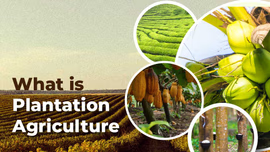Walnut Farming in India: Insights into Cultivation and Market Potential

Walnut is one of the most important nut crops of India which gets exported to more than 40 countries like Iran, UAE, Germany, Chile, Singapore, South Africa, Bhutan, etc. with earnings beyond Rs. 20 crores annually. The total area under walnut farming in India currently is around 109 thousand hectares with production of 329 thousand metric tons. This blog takes you through the various aspects of walnut farming.
Table of Contents
- Introduction and Importance of Walnut Plant
- Varieties of Walnut in India
- Cultivation of Walnut Plant in India
- Economics of Walnut Production in India
- Final Insights and Present Scenario
Introduction and Importance of Walnut Plant
Walnut is one of the oldest cultivated fruits in the world which belongs to the family of Juglandaceae. They are popularly called Akhrot or Akhroot in Hindi. The Persian walnut (Juglans regia L.) is probably native to a wide region extending from Turkey, Iraq, Iran, Afghanistan, southern Russia to northern India. Walnut plants can be grown at an elevation of 900 to 3000 m above sea level. The Indian walnuts are mainly divided into 4 categories viz., paper-shelled, thin-shelled, medium-shelled and hard-shelled.Although walnut is grown in many countries, from the past few decades its demand worldwide has increased due to its biochemical composition and health benefits. The walnut plant has a high nutritional value and a high quality of wood. Walnut is a rich source of alpha linolenic acid which provides cardio protective effects in humans. Moreover, being a source of a powerful antioxidant named melatonin, it helps in inducing and regulating sleep. It helps in preventing and controlling diseases like cancer and diabetes.Walnut oil is widely used in the cosmetic manufacturing industry due to its benefits on skin. Walnut shell flour is used as diluents for agriculture insecticides. Walnut kernels are used in confectionary and bakery items. Whereas, the immature fruits are used in making pickles, chutneys, marmalades, press juice, and syrups. Some of its species have been used for timber very likely since wood has been used for building materials.
Varieties of Walnut in India
A lot of different walnut varieties have been developed in the past few years. However, the three main traditional varieties of walnut are Juglans nigra, Jugans regia, and Juglans cinerea. Let’s take a glimpse of some of its varieties grown region wise through the table given below:
|
State |
Walnut Varieties Grown in Different States |
|
Jammu and Kashmir |
Lake English, Drainovsky and Opex Caulchry |
|
Himachal Pradesh |
Gobind, Eureka, Placentia, Wilson, Franquetfe and Kashmir Budded |
|
Uttarakhand |
Chakrata Selections |
Cultivation of Walnut Plant in India
Let’s learn how to grow walnuts by understanding the entire process of walnut cultivation ranging from land preparation to harvesting:
Climate and Soil Requirements for Walnut Farming
Walnuts flourish well in cool climates with an evenly distributed annual rainfall of 800 mm as it is suitable for its optimum growth and yield. Also, the frost conditions during spring are not appropriate for walnut growth. The ideal temperature for walnut plants should be below 38°C as above this can result in sun burning the hulls and shriveled kernels which can impact the yield.Walnuts tend to grow appropriately in well-drained deep silt loamy soils which are rich in humus and are augmented with lime. These soils include sandy loams, loams, silt loams, clay loams, and silty clay loams. They provide ideal soil conditions as roots can grow up to 10 ft or more due to good permeability, high availability of soil moisture, and adequate aeration to Favour optimum development of roots and tree growth. The ideal soil pH range for the good yield of walnuts is between 6.0 to 7.5. Make sure to add boron and zinc to the soil for additional benefits.
Land Preparation for Walnut Farming
Firstly, the land should be prepared well with all the weeds being cleared from the soil. Also, the previous crop roots should be eliminated and the land should have been ploughed 3 to 4 times to get soil tilth stage.
Propagation in Walnut Farming
In walnut farming, budding and grafting techniques for propagation have been standardized. These techniques require rootstocks and budwood/scion wood. Therefore, establishment of Bud wood/scion bank is essential to meet out the requirements as well as quality control. The popular way of propagation is through seeds so you can use local walnut seedlings as rootstocks.
Planting and Fertilizers in Walnut Farming
If you are planting walnuts in flat lands then the square system is appropriate whereas contour planting is practiced in hilly or steep slope areas with a 12x12 m space between seedling trees. Make sure you add the appropriate amount of well-rotten farm manure when you are preparing the soil. Although, manure and fertilizers are applied on the basis of leaf nutrient analysis report, you can generally apply P & K in small doses for the first five years. Later, 45-80 kg/ha of P & 65-100 kg/ha of K should be applied. A dose of 100 grams of nitrogen per tree should be applied the first year and then 100 grams more should be added every coming year.
Irrigation in Walnut Farming
Irrigate the walnut plants after transferring them from the nursery. It is important to provide sufficient irrigation from April to June due to no rains for plum kernel as well as kernel filling. On the basis of soil moisture holding capacity, weather, and season, subsequent irrigations should be provided to the crops. Drip irrigation can be utilized for proper use of water.
Weed, Pests, and Diseases Management
Appropriate use of chemical weedicide, mulching, and manual weeding can act as the preventive measures for weeds. When it comes to pest and disease management, it appears as a really a big constraint in the walnut cultivation mainly due to the difficulty faced with spraying the giant trees. Walnuts are prone to several diseases and pests, and most of them threaten the life of plants along with ruining the sizable portion of the edible nuts and their visual appearance. However, traditional control strategies work reasonably well for most pests. Also, selecting the quality disease resistance seeds majorly prevents any diseases and pest attacks.
Harvesting of Walnut
The grafted walnut trees start bearing after 3 years and become mature for harvesting after 10 to 12 years from planting. Commercial production can be expected after 18 to 20 years. Their harvesting season usually comes in September to October but it also depends on the elevation and cultivars. It is advised to not delay the harvesting process for avoiding the deteriorating of nut quality kernels.
Economics of Walnut Production in India
The global market for walnut is projected to record a compound annual growth rate (CAGR) of 6.0% over the forecast period of 2019-2024. This has increased the demand of walnuts in different industrial sectors. The major walnut growing states in India are Jammu and Kashmir, Uttarakhand, Himachal Pradesh, and Arunachal Pradesh. The Jammu & Kashmir leads both in area (85,620 ha) and production (2,75,450 MT) in India as it contributes around 98% to the total walnut output.Walnut cultivation is very labor intensive because it incurs 80 percent of total production costs. However, the cost-benefit ratio of 1:5.35 per hectare suggests better economic possibilities for the walnut industry specially in context to the Kashmir Valley. Jammu & Kashmir was once amongst the top two walnut producers in the world and today it doesn’t even stand in the top ten. There are several factors that affect its productivity and profitability like lack of infrastructures such as transport, power supply, packing facilities, and the absence of markets for the nuts. Dealing with these issues can lead to economic boost of walnut production in J&K and ultimately in India.
Final Insights and Present Scenario
Most of the walnut plantations are of seedling origin and are in scattered form which produce nuts of varying quality. It is also the fact that breeders over the years have exploited the variation amongst these seedling trees to select superior genotypes with required traits. Apart from this, improved cultivars were introduced from different nations and after complete assessment some suggestions have been made. However, walnut has usually been a low priority crop in the regions having massive apple production. A very little effort has been made for walnut production in India to unleash its potential. They suffer from lack of suitable methods of propagation, inadequate vegetatively propagated plants, lack of standard rootstocks/cultivars, problems of re-establishment of nursery plant in the orchard, particular climatic necessities, pollination behavior, lack of suitable pollinizers, long juvenile period and harvesting. The appropriate attention towards walnut production can easily waive off these concerns.


Related Blogs












